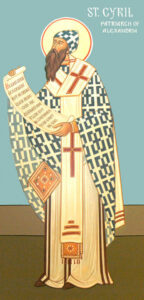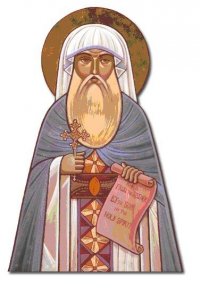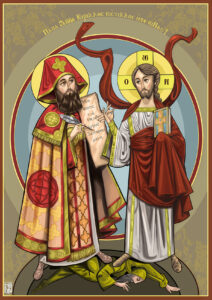St. Cyril, Patriarch of Alexandria – June 27 ‘Exalted and Veritable Tower of all knowledge’

St. Cyril, a distinguished Champion of Orthodoxy and a great teacher of the Church, was born in the town of Theodosion, Lower Egypt, in an illustrious and pious Christian family. He studied the secular sciences, including philosophy, but most of all he strove to acquire knowledge of the Holy Scriptures and the truths of the Christian Faith. Cyril’s education was thorough and comprehensive. At a young age, he studied Greek and Latin. Cyril received a classical and theological education at Alexandria. He was later trained in rhetoric, oratory and elocution, grammar, and biblical studies by the time he reached the Catechetical School of Alexandria. After finishing his studies, he became a disciple of his uncle, Patriarch Theophilus. He stayed in the patriarch’s cell, where he continued his study of the Fathers and won the heart of his uncle. His uncle was certainly present at the Council of Constantinople in 381, during which St. Cyril was a mere lad.
In his youth Cyril entered the monastery of Macarius (Dayr Aba Maqār) in the valley of Nitreia (Natrun) hills, where he stayed for six years. Theophilus (385-412), the Patriarch of Alexandria, ordained him as a deacon (reader), numbered him among the clergy, and entrusted him to preach. He accompanied Theophilus to Constantinople in 403 and he began his formal ministry.

Upon the death of Patriarch Theophilus in 412, Cyril was chosen to the patriarchal throne of the Alexandrian Church. He led the struggle against the spread of the Novatian heresy in Alexandria, which taught that any Christian who had fallen away from the Church during a time of persecution, could not be received back into it. He pillaged and closed their churches, whom he drove out from the city. In 430 Cyril became embroiled with Nestorius, patriarch of Constantinople, who was preaching that Mary was not the Mother of God since Christ was Divine and not human, and consequently she should not have the word theotokos (God-bearer) applied to her.
He persuaded Pope Celestine I to convoke a synod at Rome, which condemned Nestorius, and then did the same at his own synod in Alexandria. Celestine directed Cyril to depose Nestorius, and in AD 431, Cyril presided over the third General Council at Ephesus, attended by some two hundred bishops. He condemned Nestorianism and proclaimed Mary truly the ‘God-bearer’— the mother of the one Person who is truly God and truly human. In the confusion that followed, Emperor Theodosius II arrested both Cyril and Nestorius but released Cyril as Cyril was declared innocent of all charges. Thus, after his disposition and imprisonment, for three months, he was welcomed back to Alexandria. Two years later, Archbishop John, representing the moderate Antiochene bishops, and Cyril reached an agreement and joined in the condemnation, and Nestorius was forced into exile.
During the rest of his life, Cyril wrote treatises that clarified the doctrines of the Trinity and the Incarnation and that helped prevent Nestorianism and Pelagianism from taking long-term deep root in the Christian community. He was the most brilliant theologian of the Alexandrian tradition. His writings are characterized by accurate thinking, precise exposition, and great reasoning skills. Among his writings are commentaries on Gospel John, Luke, and the Pentateuch, treatises on dogmatic theology, and Apologia against Julian the Apostate, on the Epistles of the Apostle Paul to the Corinthians and to the Hebrews and many other letters and sermons. Of vast significance are his Five Books against Nestorius; a work on the Most Holy Trinity, written against Arius and Eunomios, two dogmatic compositions on the Most Holy Trinity, distinguished by a precise exposition of the Orthodox teaching on the Procession of the Holy Spirit.
Cyril guided the Alexandrian Church for 32 years, and towards the end of his life the flock was cleansed of heretics. Gently and cautiously, Cyril approached anyone, who by their own simpleness and lack of knowledge, fell into false wisdom. There was a certain Elder, an ascetic of profound life, who incorrectly considered the Old Testament Priest Melchizedek to be the Son of God. Cyril prayed for the Lord to reveal to the Elder the correct way to view the righteous one. After three days the Elder came to Cyril and said that the Lord had revealed to him that Melchizedek was a mere man.
Cyril learned to overcome his prejudice against the memory of the great John Chrysostom. Isidore of Pelusium, repeatedly wrote to Cyril and urged him to include the name of the great Father of the Church into the diptychs of the saints, but Cyril would not agree. Once in a dream he saw a wondrous temple, in which the Mother of God was surrounded by a host of angels and saints, in whose number was John Chrysostom. When Cyril wanted to approach the All-Holy Lady and venerate her, John Chrysostom would not let him. The Theotokos asked John to forgive Cyril for having sinned against him through ignorance. Seeing that John hesitated, the Mother of God said, “Forgive him for my sake, since he has laboured much for my honor, and has glorified me among the people calling me Theotokos.” St John Chrysostom answered, “By your intercession, Lady, I do forgive him,” and then he embraced Cyril with love. Cyril repented that he had maintained anger against the great saint of God. Having convened all the Egyptian bishops, he celebrated a solemn feast in honor of John Chrysostom.

Our Church commemorates him in the 5th Thubden, as ‘Exalted and Veritable Tower of all knowledge, who expounded the doctrine of the incarnation of God, the Word, our Lord Jesus Christ declaring and showing clearly that He became Incarnate’. He was the father of true faith, who taught true belief of the Church, about the Incarnation of Christ. He died on the 9th or the 27th of June, 444, after an episcopate of nearly thirty-two years.
0 Comments